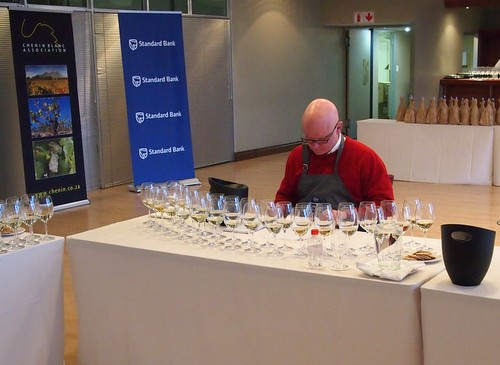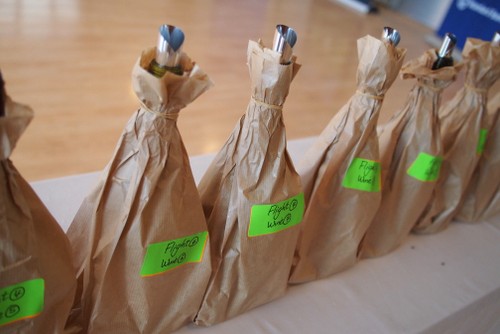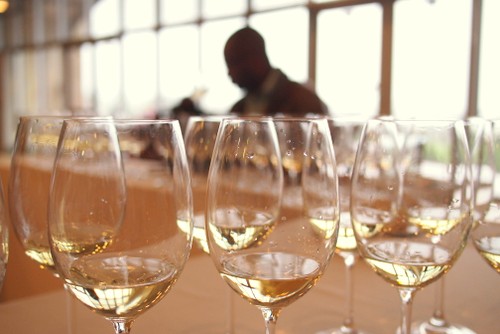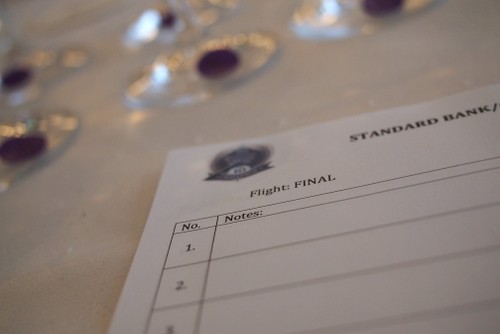
For the last couple of days I have been judging the Standard Bank Chenin Blanc Top 10 Challenge, held at Klein Zalze in Stellenbosch. 126 different wines were entered, and the panel of five, chaired by Cristian Eedes, tasted all of them, and then retasted the top 32 wines to select 10 winners. So here are some of my thoughts from spending two days immersed in South African Chenin Blanc

Chenin is lovely. And it does well in South Africa. This should be the most important take-home message. Buy it! It’s usually really great value for money.
Chenin is a chameleon variety, able to make wines in many styles. This is a positive, but it does have a downside: the problem consumers face when they try to select a bottle. They just don’t know what to expect. The words ‘Chenin Blanc’ on the label don’t give a reliable cue as to what’s in the bottle. Cheap Chenin is simple enough in this regard: it’s almost always made in a fresh, fruity, unoaked style. But for more expensive bottles, where style varies dramatically, some sort of easily understood scale on the bottle would be helpful, and I propose that it should be a visual analogue scale with three dimensions. People understand these scale bars – your battery life on your phone, the time remaining for a download, or attributes on a video game. The dimensions could be: rich and ripe to fresh and crisp; sweet to dry; and wooded to unwooded. (Probably in the other order, actually – that is, the scales start with fresh and crisp, unwooded and dry.)

Don’t make the foot fit the slipper. Making Chenin Blanc is all about intelligent interpretations of the terroir(s) you are working with. You may admire Loire Chenin (whatever that is, the style varies massively), but the Western Cape is different from the Loire. A few Chenins I tasted felt forced: it’s as if the winemaker had a stylistic goal in mind but the site (or sites) didn’t have a natural talent for this style. If your vineyard gives you rich wines naturally, then make good examples of the richer style.

Likewise, there has been a bit of a pendulum swing away from the big, rich styles. I can understand this, but it’s best if the pendulum doesn’t swing too far in the other direction. We should be praising wines for their positive virtues, not awarding them for what they are not. I would like people to think well of me because I was kind, not because I happened not to beat my wife.

Chenin Blanc doesn’t have a price ceiling in the way that Sauvignon Blanc does. It’s a variety that can make wines with greater complexity and depth as you go up the price scale, and which produces bottles that people can justify spending a lot more on. I guess this is a result of its flexible personality.
What is it that makes a Chenin highly desirable at the top end? In other words, if you wanted to create an ‘icon’ Chenin (horrible, horrible term, I know), what would it taste like? In the Loire, the most expensive wines are sweeter styles of Vouvray that live forever, and top dry wines such as the best Savennieres. These are multidimensional, complex, vital wines that combine richness with concentration and definition. For South Africa, I guess the most expensive Chenin would be Eben Sadie’s old vine series Mev Kirsten. This is a beautifully detailed wine that combines richness with precision. It’s only made in tiny quantities, but this sort of style seems to be the way to go at the very top end.
5 Comments on Consider Chenin
Love SA Chenin, not a huge fan of many of the bigger styles.
Wooded Chenin especially. My take is that there was/is lots of Chenin plantings in SA and very little Chardonnay, so the heavier styles arose as a response to fill the Chardonnay gap. Unfortunately almost all Chenin doesn’t have the complexity or ability of Chardonnay to stand up to a lot of oak.
Good article Jamie, thanks. Unless you are in the London trade or live down in South Africa, it’s hard to get to try many of these wines and form your own opinion. Whenever I have had the chance, I’ve never really been able to get my head round the grape stylistically, my cliche was that it’s kind of interesting and nutty, but then sometimes it seemed a bit blowsy and guava-like and other times just simple citrus…
As for forcing the foot to fit the slipper, I think it’s a very good take home point generally and also made me think of Aussie Chardonnay. 2 or 3 years back I think a few firms shied so far from the cliched big buttery style, that they went too far the other way. Making 11.8% unoaked battery acid might prove you´re in tune with fashion but I`m not sure how many normal people actually liked it.
Jamie
What you write here is the same for Chardonnay, especially from South Africa. We do not tell/inform the consumer what the style of the wine is on the label nor do restaurants do on their wine lists. That’s why so many still stick to Sauv Blanc when they order or buy…because they pretty much know what they gonna get.
I am looking forward to see the results of the Chenin Blanc Challenge.
Jamie, it was great to spend time with you on Thursday evening. SA’s greatest attribute is our warm dry summers and the ability to achieve richness in our wines. When this is balanced by freshness, complexity and purity, the result is a truly delicious drinking experience. The best producers are aiming to achieve this balance and it is encouraging to see consumers embracing the style. Its great to see vineyards that used to be lost in entry level ester driven wines finding their way into talented winemakers hands, and their true potential being realised. The future seems bright for SA Chenin Blanc!!!
I love SA chenin,especially that made from up to 60 year old bush vines in the Swartland.
Good to see you interest in the varietal Jamie, and I trust you will be judging the wines on a regular basis,so that you can be a reliable and informed source of information,outside the Cape.